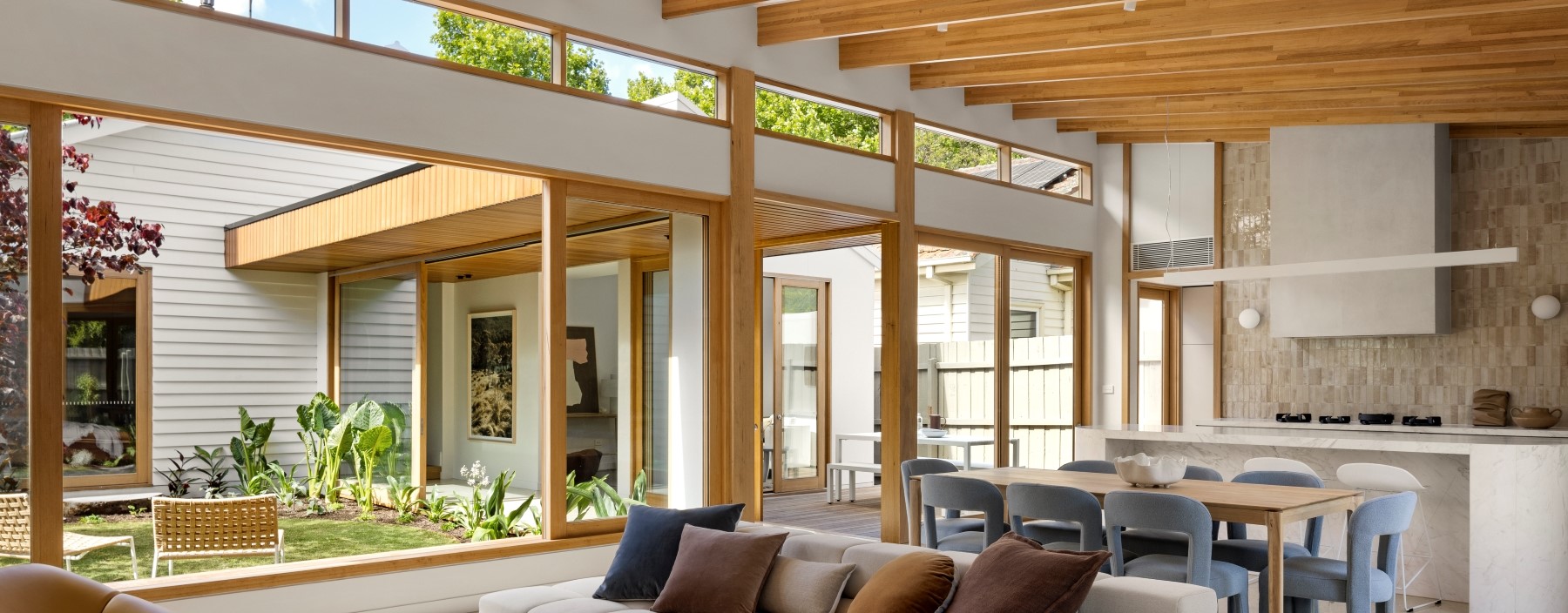Everything you need to know about Japandi design

Everything you need to know about Japandi design
Japandi isn’t just a fleeting design trend – it’s a philosophy that has become an influential architectural style in Australia. Drawing from Japanese wabi-sabi and Scandinavian hygge, Japandi design is all about finding harmony through contrast: elegance and imperfection, minimalism and warmth, simplicity and function.
From flexible layouts and calming interiors to the use of sturdy materials that can stand up to Australia’s varied climates, Japandi-style homes are designed for modern life – with beauty, wellbeing and practicality in equal measure.

The evolution of Japandi in 2025
Since popping up as a huge design style in 2024, Japandi has grown deeper roots in Australian architecture. Indeed, it continues to evolve still – embracing darker exteriors, modular elements and biophilic design for modern living needs.
More than ever, people want homes that give them a sense of peace and help them feel more connected to nature.

Why Australia has fallen in love with Japandi
Japandi suits our environment. From the use of courtyards and breezeways to a growing preference for low-maintenance materials, it naturally complements our lifestyle aspirations and climate.
“Japandi perfectly fits the Australian lifestyle, offering tranquil outdoor spaces, serene interiors and thoughtful design for living, dining, sleeping and bathing,” said registered architect and co-founder of Japandi Estate, Steph Ottavio.
Getting the best of both worlds – warmth and minimalism – means homeowners get to experience a sanctuary-like feel all year round, especially in a world that’s increasingly fast-paced and stressful.
 Alex Urena Design Studio
Alex Urena Design Studio
Key design principles: Japanese meets Scandinavian
From Japan:
- Wabi-sabi philosophy, embracing imperfection and impermanence.
- Shoji screens, sliding doors, courtyards, and water features.
- Organic shapes, natural materials and subtle detailing.
From Scandinavia:
- Hygge principles around comfort and wellbeing.
- Timber and stone materials.
- Clean lines and functional design.
- Large windows to maximise natural light.
“Japandi homes are designed to take you on a journey with purposeful spaces,” said fellow co-founder of Japandi Estate, Gian Ottavio.
The two aesthetics balance each other perfectly – Japanese design’s sleekness is softened by Nordic warmth.
Interior vs exterior: what defines Japandi design
Indoors, Japandi homes are minimalist without being cold. Expect natural timber flooring, linen textures, light-filled spaces and a general sense of calm.
Externally, the palette skews earthy and neutral, with rising popularity in dark Japandi facades – charcoals, deep browns and muted greens. This creates grounding exteriors that contrast beautifully with pale, tranquil interiors. You could pair moody exteriors in charcoal or deep browns with light, neutral interiors for a dynamic contrast.
Roof designs are kept simple and low-pitched, in keeping with the understated ethos. Deep eaves and overhangs are not only a design signature but also help with keeping homes cool in hot climates.

Designing for Australia’s weather
While Japandi is born from Nordic and Japanese influences, it’s uniquely suited to Australia. To help keep homes cool and energy-efficient, you can take advantage of cross-ventilation, deep roof overhangs and low-sill windows.
“Strategic placement of windows and doors maximises ventilation and natural light, helping reduce the need for artificial cooling and lighting systems,” said Gian.
Durable cladding is also a must for those living in harsher climates, according to Steph: “With extended roof overhangs and durable cladding, Japandi homes are designed to withstand sun, wind and rain while maintaining their aesthetic.”

Smart design tips from Steph & Gian
The minimalism in Japandi isn’t just about aesthetic restraint – it’s a tool for the budget-conscious. The key is simplifying forms and strategically choosing your materials.
“Minimalist architecture helps reduce waste and therefore construction costs,” said Steph, adding that some of their top building tips include:
- Gently sloping gable or skillion roofs to maintain elegance without excess.
- Using flat dormer sets to extend rooflines without expensive engineering.
- Minimising window mullions for a clean look and smarter use of materials.
- Prioritising built-in furniture to add function without overspending.
- Using standard window sizes to avoid expensive custom manufacturing.
 Hamlan Homes
Hamlan Homes
Exterior solutions by James Hardie for the Japandi look
To bring Japandi’s aesthetic to life, you need low-maintenance, design-led materials that can bring plenty of warmth, texture and form. The Hardie™ Architectural Collection delivers just that – with exterior solutions engineered to stand up to Australian conditions.
Some of the Hardie™" exterior products that best suit Japandi design include:
Hardie™ Brushed Concrete Cladding: A tactile texture that adds warmth and depth to the facade.

Hardie™ Fine Texture Cladding: A subtly rendered finish that matches Japandi’s clean-lined, minimalist aesthetic.

Axon™ Cladding: The vertical grooves reflect Japanese timber craftsmanship and Scandinavian precision.
Hardie™ Axent™ Trim: A robust batten option to give you clean, defined lines and create a sense of harmony throughout the exterior.
“Hardie™ Axent™ Trim creates beautiful lines and a story outside on the facade,” said Steph. “The way in which that helped me inform the interior spaces…that’s one of my favourite parts about architecture, working with natural limitations.”
If you’re dreaming of a space that nurtures your wellbeing and adapts to your needs, download the Japandi Design Handbook and read the full Modern Homes Forecast 2025 to see how you can bring this thoughtful, enduring aesthetic to life in your home.






